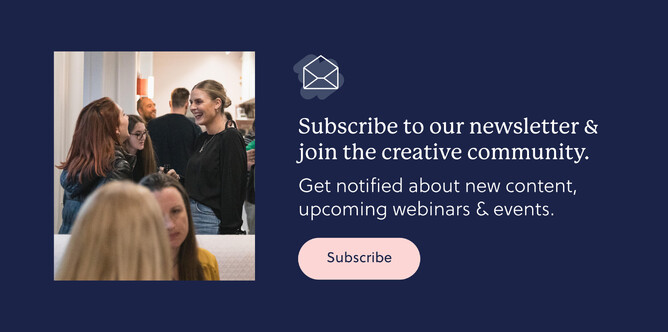As creatives, things like time management don’t always come naturally. We’d rather be designing a cool new logo for a client, or coming up with a fresh tagline for a new brand.
But, whether you want to hear it or not, time management is actually one of the key foundations which contribute to our overall success as a creative. From meeting deadlines, to assigning the correct amount of time to a project, it’s about productivity and revenue - and ensuring we aren’t overworked and underpaid.
So here’s 6 quick-fire time management tips from Jason Tiller, Rocketspark’s Head of Partnerships (and overall guru when it comes to nailing the difficult stuff we often face working as a creative).
1. Start with a ‘time audit’
The best place to start with time management is to understand what you’re working with, so for a week, commit to doing an audit on where you spend your time.
It’s important to note down everything, from account management, to replying to client emails, working on projects and even things like chores around the house. If it is something that happens during your ‘normal’ working hours, capture it.
What’s key is establishing how much time you are spending on things and when. Are you most productive in the morning when you’re fresh-faced and ready to face the day? Or are you more of a night owl, finding your creative sweet-spot in the evening when the kids are in bed?
And of course you want to identify what you’re spending too much time on. Is administration or client emails taking up far too much time (and therefore impacting on your overall profit)?
Once you have built up a reliable picture of what a typical week looks like, then you can move to make all sorts of helpful changes that should hopefully enable you to work smarter, and ensure your revenue is reflective of that.
Bonus tip: The first step to better time management is knowing where there are areas for improvement - the best results will come from being totally honest with yourself.
2. Lean heavily on to-do lists (but also, make sure you’re doing them right)
To-do lists are a self-employed person’s best friend. So if you don’t currently have a BFF, get yourself one.
But this is no ordinary to-do list, it’s one that will be with you through thick and thin because it doesn’t just have things like ‘finish client project’, it also lists the tasks required to get you to that point. Even if it is something minor, it’s best practice to have it written down so you don’t forget it (and as a bonus, you can spark joy from ticking ‘done’).
Of course as creatives, we don’t just have tasks, we have ideas - lots of wonderful ideas. So have somewhere you note these down too, they are just as important as your project tasks.
Don’t forget to prioritise your ‘to-dos’ - as it will allow you to focus on where your time needs to be spent right now, and not be distracted by other things on your list. You could colour-code them, use post-its, or choose any other way that helps you gain greater visibility - instantly - over your priorities.
Bonus tip: Make your to-do lists clearer by starting them off with a verb, so you know exactly what is required. For example, ‘social posts’ is not nearly as effective as ‘create week’s schedule for FB/Insta - copy + images’.
3. Identifying the most important task
Following on from the point above, make sure you’re constantly identifying the most important task you need to work on. So if you have a project that needs to be completed tomorrow - what’s involved with finishing it?
We all have things that linger on our lists because we don’t particularly like them, but a wise man called Mark Twain once said “If it’s your job to eat a frog, it’s best to do it first thing in the morning.”
Of course it doesn’t mean you actually have to eat a frog, but the method behind the (rather strange) saying is that if you start your day by ticking off the things that are a pain, or that you often procrastinate doing, you’ll set yourself up for a more productive day.
Bonus tip: It’s also a good idea to get an overall project perspective by organising your timeline with key milestones and most important tasks, working backwards from the final deadline for delivery.
4. Using time blocks (also known as rocks and pebbles)
If you think about your day consisting of rocks and pebbles, you can block it out using small and large chunks of time - helping you to work out what tasks need a rock and which only need a pebble.
So your client work may need a couple of rocks, say two x three-hour blocks. Then you’ll allow for a few pebbles scattered across the day to take care of answering client emails, updating your website or sending out invoices. Then you can be more protective of your ‘rocks’ and know that your ‘pebbles’ are a lot more moveable, if need be.
This approach really helps with context-switching. If you’re in a creative flow, and then it gets disrupted because something distracts you, it can take awhile to get back into that state. So if you know you’re currently in a ‘rock’, you’ll block out that time specifically for one task. And what aids with this planning is knowing when you’re most productive, and when your concentration tends to wane.
Bonus tip: Schedule your day into specific chunks of time, and do your best to stick to the ‘rocks’ and ‘pebbles’ you assign to each task.
5. Controlling your environment
When your most valuable asset is your time, it’s crucial to control your environment so you can get the most out of your time set aside for productivity.
This might mean switching off your phone or putting it on ‘do-not-disturb’, closing your email tab, and if possible, setting up a separate working space at home where you’re not likely to get interrupted.
Minimising distractions (like even locking out the cat who wants to be fed) will enable you to focus solely on the task at hand, and ensure you’re not spending more time than you need to on it.
Bonus tip: Try to set yourself with a working station that allows you to achieve a ‘rock’ without having to leave the space - it helps to minimise your working day being disrupted.
6. Protect your time and processes
Only you have the power to control your time and how you spend it. And if you put the right parameters in place, you can easily establish a protective barrier around your productivity - and not let clients or other things get in the way of what you aim to achieve each day.
Be clear with your communication - during your onboarding process, let clients know when they can expect to hear from you, and when you’re unavailable. There’s no question it shows professionalism and that you’re serious about the work you do.
Remember, you don’t have to answer your phone every time it rings, or reply to an email the instant it appears in your inbox.
Bonus tip: Use an out-of-office responder for emails, and include your ‘office hours’ on your email signature.
When you make time management a priority, it has a nice little flow-on effect that helps to increase your productivity and ultimately, your revenue. It’s about working smarter, by not just being busy with lots of things, but using your time to check off your tasks in the right order (and of course, keeping on task too!).
We’d love to hear if you have any other smart time management tricks up your sleeve - and if any of the above helps you to get yourself more organised!




